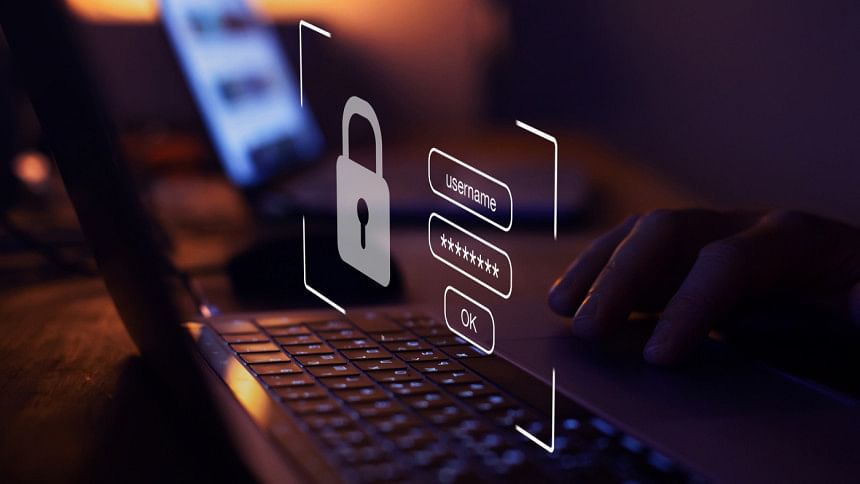Safeguarding workspaces from escalating cyber attacks: A comprehensive guide

In recent times, Bangladesh has witnessed an alarming surge in cyber-attacks and data breaches, necessitating a heightened focus on fortifying digital defences for both organisations and individuals. Incidents such as the suspected leak of five crore citizens' data from the Office of the Registrar General, Birth & Death Registration (BDRIS) have underscored the urgent need for proactive cybersecurity measures.
This article provides a comprehensive guide on how organisations can safeguard their data, secure their employees' information, prevent cyber attacks, and respond effectively in case of a breach. It also offers valuable insights into individual measures to enhance personal cybersecurity.
Establishing a robust cybersecurity framework
Organisations must prioritise the establishment of a robust cybersecurity framework tailored to their specific needs. This framework should encompass regular risk assessments, secure network configurations, strong access controls, encryption protocols, and effective incident response plans.
By conducting thorough risk assessments, organisations can identify potential vulnerabilities and devise appropriate strategies to address them. Secure network configurations, including robust firewalls and intrusion detection systems (IDS), play a pivotal role in safeguarding against unauthorised access and detecting potential threats in real time.
Strong access controls ensure that only authorised individuals can access sensitive information and systems. Furthermore, encryption protocols should be implemented to protect data at rest and in transit, rendering stolen information indecipherable to unauthorised individuals.
Finally, organisations must develop comprehensive incident response plans, detailing the steps to isolate affected systems, conduct forensic investigations, notify stakeholders, and initiate the recovery process with minimal disruption to normal operations.
Promoting employee training and awareness
Human error remains a significant factor in cyber breaches. Therefore, organisations should prioritise regular cybersecurity awareness training for employees to cultivate a culture of security. Training programs should educate employees about common cyber threats, such as phishing attacks and social engineering techniques. Additionally, employees should be trained on password hygiene, emphasising the importance of using strong and unique passwords for all accounts and avoiding password reuse across platforms.
Employees should also be encouraged to keep software and applications up to date to mitigate the risk of exploitation through known vulnerabilities. By fostering a culture of cybersecurity awareness, organisations can empower their employees to recognise and respond effectively to potential threats, ultimately reducing the risk of successful attacks.
Implementing multi-factor authentication (MFA)
One of the most effective ways to enhance security is by implementing multi-factor authentication (MFA). MFA adds an extra layer of security by requiring users to provide multiple authentication factors, such as a password and a unique verification code, before accessing sensitive information or systems. Even if passwords are compromised, MFA significantly reduces the risk of unauthorised access. Organisations should encourage the use of MFA for all applicable accounts and systems to bolster security measures.
Regularly updating and patching systems
Software vulnerabilities are often exploited by cybercriminals. To mitigate this risk, organisations must ensure that their systems, applications, and devices are regularly updated with the latest security patches and fixes. Regular updates provide crucial protection against known vulnerabilities and reduce the likelihood of successful attacks. Organisations should establish procedures to regularly monitor for available updates and promptly install them across all systems.
Emphasising data encryption and backup
Encryption plays a vital role in protecting sensitive data. Organisations should implement encryption protocols to ensure that data is encrypted at rest and in transit. By encrypting data, organisations make it significantly more challenging for unauthorised individuals to decipher stolen information. Additionally, organisations should prioritise regular backups of critical data and store them securely. Regular backups serve as a failsafe in the event of a ransomware attack or data loss, allowing organisations to restore data without succumbing to extortion demands.
Deploying robust firewall and intrusion detection systems
Deploying strong firewalls and intrusion detection systems (IDS) is crucial in preventing unauthorised access and identifying potential threats. Firewalls act as the first line of defence, monitoring incoming and outgoing network traffic and blocking unauthorised access attempts. IDS, on the other hand, continuously monitors network activity, analyses traffic patterns, and alerts administrators of any suspicious activities or potential security breaches. By deploying robust firewalls and IDS, organisations can significantly reduce the risk of successful attacks and enhance their overall cybersecurity posture.
Developing an incident response plan
Organisations should have a well-defined incident response plan in place to address potential cyber attacks. This plan should outline clear steps to isolate affected systems, conduct forensic investigations, notify relevant stakeholders, and initiate the recovery process while minimising disruption to normal operations. By establishing a comprehensive incident response plan, organisations can respond swiftly and effectively to mitigate the impact of a breach.
In the event of a cyber attack
In the unfortunate event of a cyber attack, organisations should take immediate action to minimise damage and restore normalcy:
1. Isolate and contain: Organisations must isolate affected systems and devices from the network to prevent the spread of the attack. By containing the breach, organisations limit unauthorised access to sensitive information and systems.
2. Engage cybersecurity professionals: Organisations should promptly engage cybersecurity experts, such as CIRT or reputable third-party firms. These professionals can assist in assessing the situation, mitigating the attack, and conducting forensic investigations to determine the extent of the breach.
3. Notify authorities and stakeholders: It is essential to notify the relevant authorities, such as the Computer Incident Response Team (CIRT) and law enforcement agencies, about the breach. Timely notification helps in coordinating response efforts and facilitates the investigation process. Additionally, affected individuals or stakeholders should be promptly informed to ensure transparency and enable them to take necessary precautions.
4. Preserve evidence: Organisations should preserve all available evidence related to the breach, including log files, network traffic records, and any communication with the attacker. Preserving evidence is crucial for investigations and potential legal proceedings.
5. Enhance security measures: After addressing the immediate impact of the breach, organisations should conduct a thorough analysis to identify vulnerabilities and areas for improvement. Implementing enhanced security measures can help fortify defences against future attacks.

 For all latest news, follow The Daily Star's Google News channel.
For all latest news, follow The Daily Star's Google News channel. 








Comments